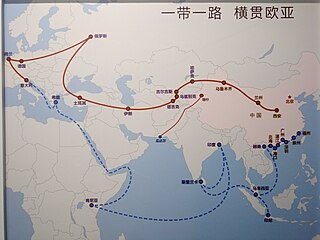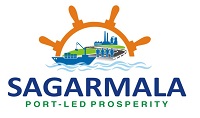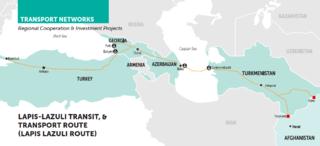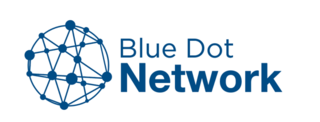
The Indo-Pacific is a vast biogeographic region of Earth.

The Indian Century is a neologism suggesting that the 21st century will be dominated by India, as the 20th century is often called the American Century, and the 19th century as Pax Britannica, as the 17-18th centuries dominated by France and the 15-16th centuries dominated by Spain. The phrase is used particularly in the assertion that the economy of India could overtake the economy of the United States and economy of China as the largest national economy in the world, a position it held from 1 to 1500 CE and from 1600 to 1700 CE.

The Economic Research Institute for ASEAN and East Asia or ERIA is an international organization established in Jakarta, Indonesia in 2008 by a formal agreement among Leaders of 16 countries in the East Asian region to conduct research activities and make policy recommendations for further economic integration in the East Asia. ERIA works very closely with both the ASEAN Secretariat and 16 Research Institutes to undertake and disseminate policy research under the three pillars, namely “Deepening Economic Integration”, ”Narrowing Development Gaps”, and “Sustainable Development” and provide analytical policy recommendations to Leaders and Ministers at their regional meetings. ERIA provides intellectual contributions to East Asian Community building and serves as a Sherpa international organization. ERIA Ranks 9th among the world's "Top International Economics Think Tanks" according to the 2020 Global Go To Think Tanks Index Report conducted by the University of Pennsylvania.
The String of Pearls is a geopolitical hypothesis proposed by United States political researchers in 2004. The term refers to the network of Chinese military and commercial facilities and relationships along its sea lines of communication, which extend from the Chinese mainland to Port Sudan in the Horn of Africa. The sea lines run through several major maritime choke points such as the Strait of Mandeb, the Strait of Malacca, the Strait of Hormuz, and the Lombok Strait as well as other strategic maritime centres in Somalia and the littoral South Asian countries of Pakistan, Sri Lanka, Bangladesh, and the Maldives.

The International North–South Transport Corridor (INSTC) is a 7,200-km long multi-mode network of ship, rail, and road route for moving freight between India, Iran, Azerbaijan, Russia, Central Asia and Europe. The route primarily involves moving freight from India, Iran, Azerbaijan and the Russian Federation via ship, rail and road. The objective of the corridor is to increase trade connectivity between major cities such as Mumbai, Moscow, Tehran, Baku, Bandar Abbas, Astrakhan, Bandar Anzali, etc. Dry runs of two routes were conducted in 2014, the first was Mumbai to Baku via Bandar Abbas and the second was Mumbai to Astrakhan via Bandar Abbas, Tehran and Bandar Anzali. The objective of the study was to identify and address key bottlenecks. The results showed transport costs were reduced by "$2,500 per 15 tons of cargo". Other routes under consideration include via Kazakhstan and Turkmenistan.

The Bangladesh, China, India and Myanmar Economic Corridor (BCIM) was a proposed corridor connecting India and China through Myanmar and Bangladesh as a corridor.

The South Asia Subregional Economic Cooperation (SASEC) Program, set up in 2001, brings together Bangladesh, Bhutan, India, Maldives, Myanmar, Nepal, and Sri Lanka in a project-based partnership to promote regional prosperity by improving cross-border connectivity, boosting trade among member countries, and strengthening regional economic cooperation. As of June 2020, SASEC countries have implemented 61 regional projects worth over $13 billion in the energy, transport, trade facilitation, economic corridor development, and information and communications technology (ICT) sectors. The Manila, Philippines-based Asian Development Bank (ADB) serves as the Secretariat for the SASEC member countries.

The 21st Century Maritime Silk Road, commonly just Maritime Silk Road (MSR), is the sea route part of the Belt and Road Initiative which is a Chinese strategic initiative to increase investment and foster collaboration across the historic Silk Road.
An industrial corridor is a package of infrastructure spending allocated to a specific geographical area, with the intent to stimulate industrial development.

The Belt and Road Initiative, known within China as the One Belt One Road or OBOR/1B1R for short, is a global infrastructure development strategy adopted by the Chinese government in 2013 to invest in more than 150 countries and international organizations. It is considered a centerpiece of the Chinese leader Xi Jinping's foreign policy. The BRI forms a central component of Xi's "Major Country Diplomacy" strategy, which calls for China to assume a greater leadership role for global affairs in accordance with its rising power and status. It has been compared to the American Marshall Plan. As of August 2023, 155 countries were listed as having signed up to the BRI. The participating countries include almost 75% of the world's population and account for more than half of the world's GDP.

The Sagarmala Programme is an initiative by the Government of India to enhance the performance of the country's logistics sector. The programme envisages unlocking the potential of waterways and the coastline to minimize infrastructural investments required to meet these targets.
Visakhapatnam–Chennai Industrial Corridor (VCIC), also Vizag–Chennai Industrial Corridor, is a key part of the East Coast Economic Corridor (ECEC), India's first coastal corridor. VCIC is aligned with the Golden Quadrilateral and is poised to play a critical role in driving India’s Act East Policy and Make in India campaign. The nearly 800-kilometer corridor links India with the Association of Southeast Asian Nations (ASEAN) and East Asian economies that form the bedrock of global manufacturing economy. The corridor traverses nine districts of the state of Andhra Pradesh. VCIC intends to complement the ongoing efforts of the Government of Andhra Pradesh (GoAP) to enhance industrial growth and create high quality jobs.

The East Coast Economic Corridor (ECEC) is India’s first coastal economic corridor covering 2500 km of India's coastline, to be developed with the help of the Asian Development Bank (ADB). The ADB is to invest $500 million in infrastructural development of the project. Since late 2013, ADB has been supporting studies on transport corridors in India. Phase 1 of the ECEC is Visakhapatnam-Chennai Industrial Corridor (VCIC) which had been approved by the ADB board in October 2016. The ECEC running along the entire east coast of India from Kolkata to Kanyakumari, is a multimodal, regional maritime corridor that can play a vital role in unifying the large domestic market, as well as integrating the Indian economy with the dynamic global value chains of Southeast and East Asia. It would play a crucial role in the Government of India’s (GoI) Make in India campaign and also supports the port-led industrialization strategy under the Sagar Mala initiative and the Act East Policy by linking domestic companies with the vibrant global production networks of East and Southeast Asia.
Water transport in India has played a significant role in the country’s economy and is indispensable to foreign trade. India is endowed with an extensive network of waterways in the form of rivers, canals, backwaters, creeks and a long coastline accessible through the seas and oceans. It has the largest carrying capacity of any form of transport and is most suitable for carrying bulky goods over long distances.
Multi-Modal Logistics Parks (MMLPs) is a key policy initiative of the Government of India, led by National Highways Logistics Management Limited under Ministry of Road Transport and Highways (MoRTH) and the National Highways Authority of India (NHAI), to develop Multi-Modal Logistics Parks in hub-and-spoke model to improve the country's freight logistics sector by lowering overall freight costs and time, cutting warehousing costs, reducing vehicular pollution and congestion, improving the tracking and traceability of consignments through infrastructural, procedural, and information technology interventions.

Lapis Lazuli is an international transit route opened in 2018 linking Afghanistan to Turkey via Turkmenistan, Azerbaijan and Georgia.
Indian foreign aid is the aid given by the Indian government to other governments. India's major quantum of foreign aid is given to neighbouring countries. According to India's budget in 2021–22, its direct overseas aid stood at ₹18,154 crore (US$2.3 billion). That apart, India also extended a direct line of credit worth $30.66 billion to several foreign countries for developmental projects. The way of providing a much larger share of aid in the form of concessional loans is quite similar to that of China. India has set up 'Indian Agency for Partnership in Development' as a part of Ministry of External Affairs (India) to channelize aid to recipient nations.

The Blue Dot Network (BDN) is a certification framework for quality infrastructure projects. The initiative is a joint project of the governments of Australia, Czech Republic, Japan, Spain, Switzerland, United Kingdom, and the United States that supports investment in high-quality infrastructure projects around the world, especially by the private sector.
Build Back Better World (B3W) is an initiative undertaken by the G7. Launched on June 12, 2021, it would provide an alternative to China's Belt and Road Initiative (BRI) for infrastructure development of low- and middle-income countries.

The Partnership for Global Infrastructure and Investment (PGII) is a collaborative effort by Group of Seven to fund infrastructure projects in developing nations based on the trust principles of the Blue Dot Network. It is considered to be the bloc's counter to China's Belt and Road Initiative and a key component of the "Biden Doctrine".













